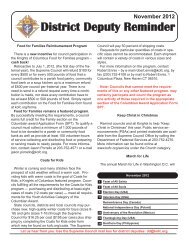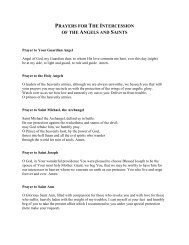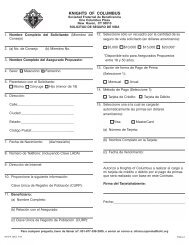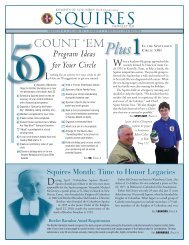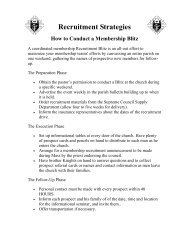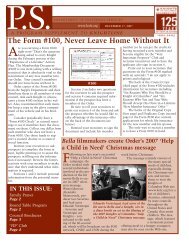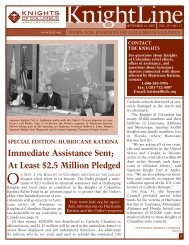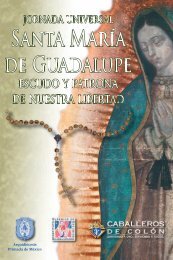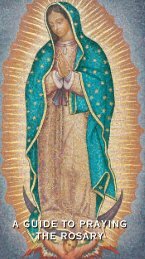Chaplain's Handbook (#945) - Knights of Columbus, Supreme Council
Chaplain's Handbook (#945) - Knights of Columbus, Supreme Council
Chaplain's Handbook (#945) - Knights of Columbus, Supreme Council
You also want an ePaper? Increase the reach of your titles
YUMPU automatically turns print PDFs into web optimized ePapers that Google loves.
Lacking funds and concerned about his family, he went home to the funeral,<br />
lingering a while in Waterbury. Then, at the request <strong>of</strong> the bishop <strong>of</strong> Hartford, he<br />
entered St. Mary’s Seminary in Baltimore. After four years <strong>of</strong> study, on December<br />
22, 1877, he was ordained in Baltimore’s historic Cathedral <strong>of</strong> the Assumption by<br />
Archbishop (later cardinal) James Gibbons. A few days later, with his widowed<br />
mother present, he said his first Mass at Immaculate Conception Church in<br />
Waterbury.<br />
Father McGivney began his priestly ministry on Christmas Day in 1877 as<br />
curate <strong>of</strong> St. Mary’s Church in New Haven. It was the city’s first parish. A new stone<br />
church had been built, after the old one burned, on one <strong>of</strong> New Haven’s finest<br />
residential streets, Hillhouse Avenue. There was neighborhood objection which<br />
even The New York Times noted in 1879, under the headline, “How An Aristocratic<br />
Avenue Was Blemished By A Roman Church Edifice.” So Father McGivney’s priestly<br />
ministry in New Haven began with tension and defensiveness among the workingclass<br />
Irish families he served.<br />
One <strong>of</strong> the responsibilities <strong>of</strong> St. Mary’s priests was pastoral care <strong>of</strong> inmates <strong>of</strong><br />
the city jail. In a notable case, a 21-year-old Irishman, while drunk, shot and killed a<br />
police <strong>of</strong>ficer. James (Chip) Smith was tried for first-degree murder in 1881,<br />
convicted and sentenced to be hung. Father McGivney visited him daily. After a<br />
special Mass on the day <strong>of</strong> execution, the priest’s grief was intense. The young<br />
<strong>of</strong>fender comforted him: “Father, your saintly ministrations have enabled me to meet<br />
death without a tremor. Do not fear for me, I must not break down now.”<br />
Father McGivney worked closely with the young people <strong>of</strong> St. Mary’s parish,<br />
holding catechism classes and organizing a total abstinence society to fight<br />
alcoholism. In 1881 he began to explore with various laymen the idea <strong>of</strong> a Catholic<br />
fraternal benefit society. In an era when parish clubs and fraternal societies had<br />
wide popular appeal, the young priest felt there should be some way to strengthen<br />
religious faith and at the same time provide for the financial needs <strong>of</strong> families<br />
overwhelmed by illness or death <strong>of</strong> the breadwinner.<br />
He discussed this concept with Bishop Lawrence McMahon <strong>of</strong> Hartford, and<br />
received his approval. He traveled to Boston to talk with the Massachusetts<br />
Catholic Order <strong>of</strong> Foresters, and traveled to Brooklyn to consult the Catholic<br />
Benevolent Legion. He met with other priests <strong>of</strong> the diocese. Whenever he could,<br />
he sought information that would help the Catholic laymen to organize themselves<br />
into a benefit society.<br />
People who knew Father McGivney in this period were impressed by his energy<br />
and intensity. Father Gordian Daley later recalled: “I saw him but once, and yet I<br />
remember this pale, beautiful face as if I saw it only yesterday. It was a ‘priest’s face’<br />
and that explains everything. It was a face <strong>of</strong> wonderful repose. There was nothing<br />
harsh in that countenance although there was everything that was strong.”<br />
William Geary, one <strong>of</strong> the Order’s charter members, said that at the first council<br />
meeting in 1882 he “was acclaimed as founder by 24 men with hearts full <strong>of</strong> joy and<br />
thanksgiving, recognizing that without his optimism, his will to succeed, his counsel<br />
and advice they would have failed.”<br />
21




